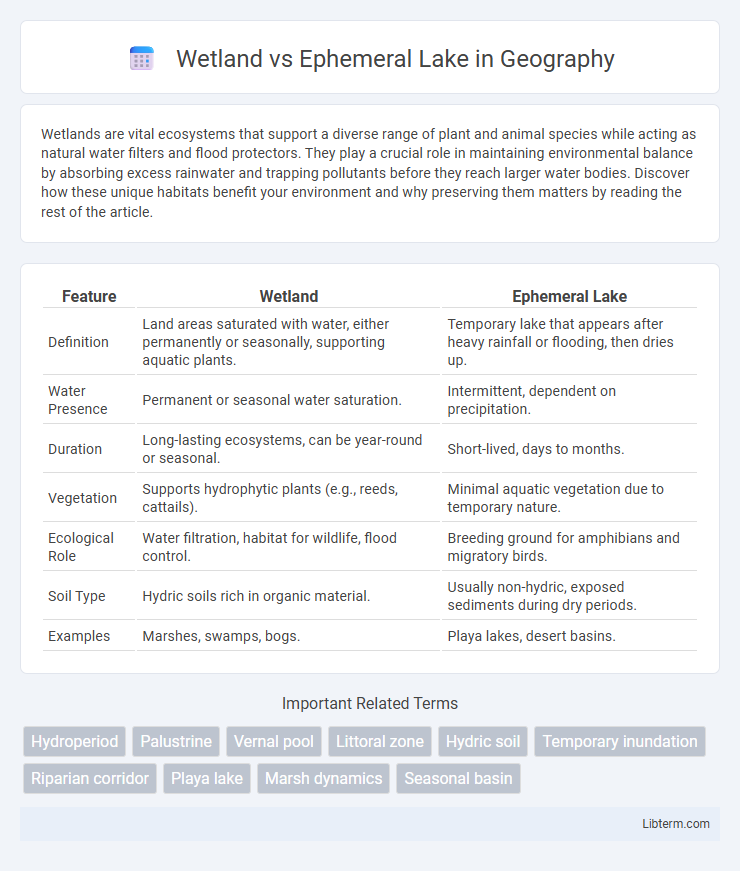Wetlands are vital ecosystems that support a diverse range of plant and animal species while acting as natural water filters and flood protectors. They play a crucial role in maintaining environmental balance by absorbing excess rainwater and trapping pollutants before they reach larger water bodies. Discover how these unique habitats benefit your environment and why preserving them matters by reading the rest of the article.
Table of Comparison
| Feature | Wetland | Ephemeral Lake |
|---|---|---|
| Definition | Land areas saturated with water, either permanently or seasonally, supporting aquatic plants. | Temporary lake that appears after heavy rainfall or flooding, then dries up. |
| Water Presence | Permanent or seasonal water saturation. | Intermittent, dependent on precipitation. |
| Duration | Long-lasting ecosystems, can be year-round or seasonal. | Short-lived, days to months. |
| Vegetation | Supports hydrophytic plants (e.g., reeds, cattails). | Minimal aquatic vegetation due to temporary nature. |
| Ecological Role | Water filtration, habitat for wildlife, flood control. | Breeding ground for amphibians and migratory birds. |
| Soil Type | Hydric soils rich in organic material. | Usually non-hydric, exposed sediments during dry periods. |
| Examples | Marshes, swamps, bogs. | Playa lakes, desert basins. |
Introduction to Wetlands and Ephemeral Lakes
Wetlands are ecosystems characterized by the presence of water, either permanently or seasonally, supporting diverse plant and animal species adapted to saturated soil conditions. Ephemeral lakes are temporary water bodies that form in depressions following precipitation events and dry out during periods of drought, influencing local hydrology and biodiversity. Both wetlands and ephemeral lakes play critical roles in water filtration, flood control, and habitat provision within their respective landscapes.
Defining Wetlands: Key Characteristics
Wetlands are distinct ecosystems characterized by saturated soils, diverse vegetation adapted to hydric conditions, and prolonged water presence supporting rich biodiversity. Unlike ephemeral lakes, wetlands maintain water levels seasonally or permanently, facilitating critical ecological functions such as water filtration, flood control, and habitat provision. Key indicators include hydrophytic plant species, hydric soils, and hydrology that differ significantly from the temporary inundation seen in ephemeral lakes.
Understanding Ephemeral Lakes: Temporary Water Bodies
Ephemeral lakes are temporary water bodies that form in low-lying areas following periods of rainfall or flooding and typically dry up within weeks or months. Unlike permanent wetlands, ephemeral lakes support unique ecosystems adapted to fluctuating water availability, providing critical habitats for migratory birds, amphibians, and specialized plants during their wet phases. The hydrological dynamics of ephemeral lakes influence soil moisture, groundwater recharge, and nutrient cycling, playing a vital role in regional biodiversity and landscape connectivity.
Hydrological Differences: Permanence and Water Cycles
Wetlands maintain water presence either permanently or seasonally due to consistent groundwater inputs or surface water accumulation, supporting prolonged hydrological stability. Ephemeral lakes experience transient water bodies that appear only after rainfall or snowmelt, leading to rapid filling and drying cycles without sustained water sources. These differences in water permanence and cyclical patterns shape distinct ecological functions and biodiversity in each habitat.
Biodiversity Comparison: Flora and Fauna
Wetlands support higher biodiversity than ephemeral lakes due to their stable water availability, enabling diverse plant communities such as cattails, sedges, and water lilies to thrive, which in turn provide habitats for amphibians, birds, and aquatic invertebrates. Ephemeral lakes, with their intermittent water presence, host specialized flora like salt-tolerant grasses and opportunistic algae, and fauna adapted to rapid colonization cycles, including migratory birds and crustaceans. The fluctuating conditions of ephemeral lakes limit species richness compared to the more consistent ecosystems found in wetlands.
Ecological Functions and Benefits
Wetlands provide critical ecological functions including water filtration, flood control, and habitat for diverse species, supporting high biodiversity and nutrient cycling. Ephemeral lakes offer temporary aquatic habitats that replenish groundwater, support migratory birds, and enable nutrient export during periodic flooding events. Both ecosystems contribute significantly to regional water balance and serve as vital refuges for wildlife during varying hydrological conditions.
Geographic Distribution and Formation
Wetlands occur globally in diverse climatic zones, forming where water saturates the soil either permanently or seasonally, often along river margins, coastal areas, and low-lying regions. Ephemeral lakes are typically found in arid and semi-arid regions such as deserts or dry basins, forming temporarily after episodic rainfall events that fill depressions or basins. The formation of wetlands involves sustained hydrological input, soil saturation, and vegetation adaptations, whereas ephemeral lakes result from transient hydrological conditions with rapid filling and drying cycles.
Human Impact and Land Use
Wetlands serve as crucial ecosystems that filter pollutants, support biodiversity, and regulate water cycles, but human activities such as urban development, agriculture, and draining for land conversion have resulted in significant wetland loss and degradation. Ephemeral lakes, characterized by periodic drying, are highly sensitive to land use changes including water extraction, soil compaction, and pollution from nearby farming or mining operations, which disrupt natural hydrological patterns and reduce habitat availability for dependent species. Conservation efforts centered on sustainable land management and pollution control are essential to mitigate human impact and preserve the ecological functions of both wetlands and ephemeral lakes.
Conservation Challenges and Strategies
Wetlands face conservation challenges such as habitat degradation due to pollution, invasive species, and altered hydrology, requiring strategies like water quality management and habitat restoration. Ephemeral lakes present unique challenges including unpredictable water availability and rapid ecological changes, addressed by adaptive management and protecting surrounding watersheds. Both ecosystems benefit from integrated conservation approaches that prioritize biodiversity, hydrological balance, and community engagement.
Conclusion: Selecting the Right Approach to Protection
Wetlands provide sustained habitat diversity and water filtration, whereas ephemeral lakes offer crucial but temporary aquatic environments supporting unique species during wet phases. Effective protection strategies must prioritize wetlands for long-term ecological stability and prioritize ephemeral lakes for preserving seasonal biodiversity and hydrological cycles. Combining conservation efforts ensures the resilience of both ecosystem types and supports broader landscape-level environmental health.
Wetland Infographic

 libterm.com
libterm.com